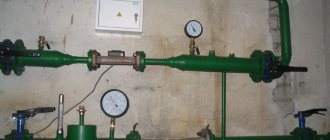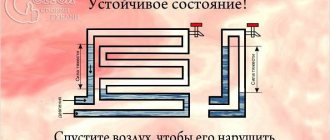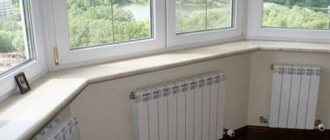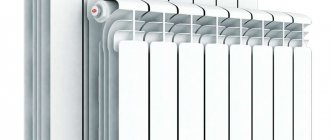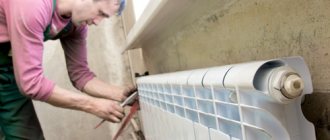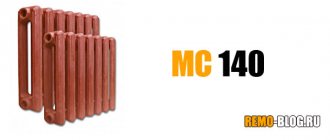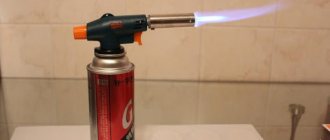The heating season is already beginning, and with it comes the annual problems: cold “radiators” in apartments. Specialists from ROYAL THERMO, one of the recognized leaders in the production of high-quality radiators, have compiled a top list of reasons why heating devices refuse to work. Perhaps he will help make the correct “diagnosis” and return the long-awaited comfort to your home.
“To find out exactly what happened to your heating devices and correct the situation,” says Yulia Zvyagina, technical specialist at ROYAL THERMO, “in most cases you need the intervention of a professional. Therefore, before purchasing a radiator, try to eliminate future troubles in advance.”
Let us note right away: before blaming the radiator for the malfunction, you need to make sure that the reason does not lie in “under-fueling” due to the fault of the utility workers. To do this, you just need to ask your neighbors - if they are also cold and the heating of the heating riser pipe is the same throughout the house, then you need to demand the truth from your management company or HOA. If other apartments are warm, but the riser is hot, then the problem is really in the battery. And we can name five main reasons for this situation.
1. Air lock. In general, this is the simplest and most common reason for the lack of heat, which is also the easiest to eliminate. If, when filling the radiator, an air bubble forms in its upper part, it can, like a plug, completely block the circulation. Dealing with this problem is quite simple: radiators are equipped either with a special tap, which you just need to open and bleed off the air, or with the so-called “Maevsky taps” - a needle air valve. You need to press it counterclockwise with a regular screwdriver and also wait for the bubble to come out. In any case, when performing these manipulations, it is worth placing a container under the radiator for draining water - this will protect the floors.
2. Debris in the radiator manifold. As you know, the quality of the coolant in most domestic networks leaves much to be desired. The liquid is often highly mineralized due to constant replenishment with untreated water, and worn-out pipelines also add a suspension of rust and scale. All this dirt inevitably settles on the walls of the radiator, narrowing the passage, impairing the thermal conductivity of the walls and disrupting circulation. But even if the coolant is free of flaws, contamination can appear due to the poor quality of the heating device itself. “For example, uneven filling of a steel collector with aluminum, which is often found in cheap no-name models and fakes, will inevitably lead to corrosion,” explains Yulia Zvyagina, technical specialist at ROYAL THERMO, “and its products will definitely end up on the walls of the collector, which, naturally, will negatively affect the operation of the device." Unfortunately, if there is debris and deposits, the battery will have to be removed and washed or, in advanced cases, replaced with a new one.
3. The radiator is not connected correctly. This is quite easy to determine: if only part of the device is heated (the top is hot and the bottom is cold or vice versa; only a few sections are heated), this is your case. Most likely, the wrong type of connection has been selected (the relative position of the coolant inlet and outlet). There are three of them in total: diagonal, bottom and side. The first is the most effective and will ensure uniform heating of the device. If hot water enters and leaves from below, then most often it simply does not have time to warm up the top. In this case, it is necessary to install a liquid flow extension - this is a pipe that allows the water to “linger” in the collector, heating it more evenly. With a side connection (both pipes on one side of the battery), usually only the first 3-4 sections have time to heat up. In this case, you will have to call a specialist and reconnect the radiator.
4. Communal problems. Firstly, it is the presence of a single-pipe heating system. Unfortunately, since Soviet times, most old apartment buildings have been equipped with this system. Due to technological features, the further a modern radiator is from the heating riser, the colder it will be. Secondly, the pressure in the system is too low. Usually associated with the deterioration of the infrastructure of old houses or design errors. Alas, in this situation only a major overhaul with a complete rework of the circuit will help.
5. Incorrect installation of the thermostat. Saving rapidly rising heat with the help of thermostatic heads is a good thing, but requires a qualified approach. If your neighbors installed such a thermostat and did not take care of the bypass pipe (it will ensure the circulation of hot water, even if the neighbor’s “battery” is completely blocked), the cold in your apartment is inevitable. Therefore, you need to boldly go to them and find out what and how. If there is no such pipe, require alteration. If they refuse, go to the management company or homeowners association, where they will be forced to make this modification forcibly.
So, we tried to find out why the heating season began, but there was still no heat. And since the causes of the problem are clear, you need to try to solve them - on your own or with the help of a specialist. The main thing is not to give up!
Royal Thermo is one of the largest manufacturers of radiators and components for heating systems, successfully represented on the Russian market since 2002. During this time, more than 25 million products under the Royal Thermo brand were sold. Since 2010, Royal Thermo has been cooperating with the Italian concern Faral, one of the market leaders, which in 1966 revolutionized domestic heating by starting to produce the world's first cast aluminum radiators. Many years of experience, a highly specialized focus of production, the introduction of innovative technologies and revolutionary design solutions have enabled Royal Thermo and Faral to develop a unique range of aluminum and bimetallic radiators aimed at the market in Russia and the CIS countries.
Powerful scientific and technical potential and market knowledge allowed Royal Thermo to create an ultra-modern production holding with headquarters and its own design studio in the province of Vicenza, and with factories in Italy (Orgiano) and Russia (Kirzhach, Vladimir region).
At a factory in Italy, RoyalThermo produces premium designer radiator models, professional piping and heating system elements. The Russian plant in the Vladimir region is designed for the annual production of more than 12 million sections and specializes in the mass production of high-tech models of radiators and components for energy-efficient construction. A multi-stage quality control system at all stages of production allows us to produce high-tech products (more than 10 international patents) with excellent thermal and strength characteristics. The production of radiators is certified in accordance with the international standards ISO 9001, ISO 14001.
Royal Thermo – made by the experts!
The battery does not heat in a private house
The reason why batteries in a private home do not heat up may be a number of factors. We can only consider the question in general. There are different reasons and they are not always obvious. Sometimes such a small thing as a faulty faucet or a clogged chimney can become a stumbling block. Despite this, there are no hopeless situations, the main thing is to determine the reason why the battery in a private house does not heat, the rest is a matter of technology.
Insufficient boiler power
If the radiators in a private house do not heat well, then one of the reasons may lie in the heating boiler. In your home, you can say with almost 100% probability that the heating circuit is autonomous. So the boiler is standing. It could be:
Why do batteries heat poorly in a private home? The reason may be an incorrectly selected boiler power. That is, it does not have enough resources to heat the required amount of liquid. The first sign that the power has been selected incorrectly is the constant operation of the heating device, without shutdowns.
Although in this case the heat exchangers will heat up at least a little. And if the water in them is completely cold, it means that the boiler is broken or cannot turn on. Modern units have a minimum pressure requirement in the system. If this requirement is not met, it will not turn on. In addition, there is an automation and security system.
Let's take, for example, a gas boiler. It contains a sensor that monitors that all gases go into the chimney. It is possible that the chimney or some smoke outlet pipe is clogged. In any case, the sensor will send a command to the control unit and it will not allow the boiler to turn on.
Here you will find information on how to repair a heating radiator with your own hands.
Problems with the batteries themselves
The batteries in a private house do not heat up, what should I do? If no problems are found with the boiler and it is working correctly, then the reason why the batteries are cold should be looked for in the circuit itself. Possible options:
- airing;
- pollution;
- insufficient pressure;
- incorrect pipe routing;
- Incorrect connection of heat exchangers.
If the batteries are cold, then you need to check all the above factors. More details about what to do if the batteries do not heat up
we already wrote. The specificity of a private house is that all characteristics can be controlled independently.
You need to check the circuit for air pockets. There are special taps and air vents for this.
Then make sure there is no dirt in the pipes and heat exchangers. How to do it? You will have to drain water from cold radiators in a private house. What to do is known, you need to unscrew one end (bottom) of the battery and substitute a larger vessel. If black water flows, then there is nothing to think about - this is pollution. It is necessary to rinse the circuit to clean water. Sometimes thick liquid flows out of radiators along with water. This is dirt collected in copious amounts.
What other reasons could there be for cold radiators in a private home? If the problem is not air or pollution, then circulation is broken. This may be due to low blood pressure. In general, in an autonomous circuit the coolant pressure does not exceed two atmospheres. If you have new batteries, then look at their data sheet. In modern heat exchangers, the operating pressure requirements are higher than in Soviet models. Pay attention to this.
If you want to repair the heating systems of a country house with your own hands, then this is the place for you.
The radiator does not heat. What to do?
- share on social networks
With the onset of cold weather, many are faced with the problem of non-functioning radiators and ask a reasonable question: “Why are the batteries cold? After all, everything was fine last winter.” This problem, by the way, is one of the most common in the heating sector. Why does this happen, what reasons can provoke the problem and what should you do if you freeze at the very beginning of winter? Let's figure it out.
Are the radiators in your apartment heating poorly?
So, first you need to do a superficial check. It doesn’t take much time, but in this way you can eliminate factors not related to breakdown or malfunction.
1. Pay attention to the valve. The battery may be blocked. In order to assess whether the valve is in the correct position, you need to remember that when open it must stand parallel to the pipe. When the valve is closed, it takes a perpendicular position. For clarity, take a look at the picture.
2. Contact the management company. There they must inform you about heating outages.
3. Discuss the problem with your neighbors. In many houses in our country, the coolant supply system is a single-pipe version. In simple terms, with such a system, one pipe goes to the ceiling and one to the floor. In addition, neighbors, as a rule, do not have jumpers between pipes (bypasses). Thus, when a neighbor on the second floor blocks the radiator, all the residents above will suffer, since heating, in this case, is turned off for all apartments along the riser. What should be done? It's simple: check if the heating of your neighbors below and above is blocked (in some cases, the coolant is supplied from the upper floors).
We recommend: RCD - how it works, device, choice of power for an apartment, private house
We have looked at the simplest reasons that can make you freeze in your own apartment. Unfortunately, heating problems are not always of such a banal nature, so we suggest that you familiarize yourself with the malfunctions and problems that are directly related to heating radiators.
Disruption of coolant circulation
What other reasons could there be for cold radiators in a private home? If the problem is not air or pollution, then circulation is broken.
Poor circulation can lead to unpredictable results.
We will separately consider the disruption of coolant circulation due to improper pipe routing and piping of heat exchangers, as a result of which the batteries are cold. In your home, you are free to choose the method of pipe routing. It could be:
- two-pipe heating system;
- single-pipe heating system.
It so happened that many people previously preferred a single-pipe heating system, also known as “Leningradka”. It was believed that it was simpler and cheaper, but in reality this is not the case. In addition, in this scheme it is very difficult to regulate the temperature of the heat exchangers as they move away from the boiler room. The farther from the boiler, the more sections there should be. Therefore, it is not uncommon that the last battery in a private house does not heat. The coolant flows through one pipe. In such a scheme there is no return.
It turns out that water enters the heat exchanger, cools there and is again drawn into the general flow. Accordingly, after each radiator the overall flow becomes colder. The difference increases with distance from the heating element. As a result, the water may reach the extreme heat exchanger almost cold.
In a two-pipe system, errors may be made in the piping:
- incorrectly installed shut-off valves;
- incorrect connection of the heat exchanger (there are three types: side, bottom, diagonal);
- The diameter of the bends is incorrectly selected.
For these reasons, circulation is disrupted and a negative result is obvious, namely a cold battery.
Insulating a home - materials, technologies, tips
After abandoning central heating and switching to autonomous heating, one drawback was noticed: in one of the rooms, with ten sections of the radiator, only 2 warmed normally, all the rest were only a little warm.
I replaced the old cast iron batteries with new aluminum ones. The advantages of aluminum radiators are that they are lightweight, heat up quickly, have a beautiful appearance, quick installation, and do not require painting. The disadvantages include rapid cooling.
Why doesn't my new aluminum battery heat up completely? The first thing that came to my mind was that maybe something had gotten in there and was preventing water from circulating in the radiator. But after studying this issue in detail, I found the reason. Everything turned out to be quite simple. The supply and return lines were reversed. That is, the supply was carried out from below, and the return was discharged from above.
The radiator heating circuit was approximately as follows:
What the hell did the specialists in installing individual heating come up with?
They installed an additional tap on the lintel near the battery. But this decision yielded virtually no results. And the consequences of this can be colossal, including failure of the boiler, if someone closes this valve and the battery at the same time.
How did I solve this problem? I took it and changed the supply and return in some places.
To do this, you need to drain the water from the heating system, which is done by unscrewing the bottom plug on the radiator. Unscrew it gently and slowly, since there is a pressure of up to 2 atmospheres in the system. You need to place some container underneath.
Then, in one of the sections of the heating pipeline, I dismantled the pipes and swapped them. I pumped water into the system and did a test run.
I deflated the air and drained 200 grams of water to fully ensure that all the air was gone. And now the radiator began to warm up completely and evenly. And I almost went to the store to buy a new one.
It has already become common for us to live in a warm house all year round, regardless of the temperature outside the window. The heating system, which everyone usually forgets about, maintains comfort, but as soon as the temperature drops, they remember its existence. If your home is cold, our article will help you figure out why the radiators are not heating.
No circulation, heating failure - why
Failure in the heating system, deficiencies, imperfections, all lead to cold radiators. If there is no coolant circulation, then the reason needs to be determined. Most often, the answer to why the heating does not work is on the surface, obvious.
Let's look in order at the main causes of heating malfunctions, why water does not circulate through the pipes, and what needs to be done first.
Let's start with the simplest and most obvious reasons.
clogged, clogged
Every heating system must have a coarse filter. A very small device with a fine mesh and a sump (installed downwards! or at least to the side) saves equipment, pumps, and the boiler from coolant contamination that will be present in any system. Wood shavings, broken threads, rust, water sediment…. everything is retained by the mesh in the filter.
The sedimentation tank must be periodically untwisted and the mesh cleaned.
If the circulation in the heating system of a private house is disrupted, then the first thing you need to do is check the filter, which should be installed on the return line in front of the boiler.
Air in the system, airing
Airing can occur in any closed piping system where air removal measures have not been taken. Air is always present in the coolant, including in a dissolved state, is released during pressure changes, and accumulates at the highest points. Including in the boiler.
Automatic air vents are installed at characteristic, highest points of the system, as well as on collectors and special separators - the normal circuit is equipped with a special air catching device in which air bubbles are released from the coolant.
We recommend: Boiler equipment from the Ural Plant
In addition, Mayevsky valves (manual air vents) should be on each radiator, and also possibly in other elevated places.
Checking the air supply, bleeding the air, installing air vents are common actions if circulation stops and the batteries are cold.
The circulation pump does not work
In private homes, the reason why the heating system stops working is a breakdown of the electrical equipment that controlled the movement of the coolant through the pipes.
If the heating suddenly stops working, then you need to check the functionality of the circulation pump near the solid fuel boiler or the pump in the automated boiler. In addition, the same unit can be installed in each circuit, which must work properly.
Bad polypropylene pipes
Often the consumer (customer) believes that polypropylene pipes are absolutely reliable and cannot cause heating problems or cold radiators.
But polypropylene is much more insidious than old steel or metal-plastic pipelines. Each place of soldering (welding) is a potential increased resistance in the system or a cause of cessation of circulation (weakened movement of water through the batteries), due to deposits of material inside.
It is impossible to control the quality of connections from the outside; all that remains is to cut out pieces, resolder, and remake polypropylene pipes.
Poor performance of a polypropylene system is a real problem for the home installer. Good professionals don’t take on this material at all.
Bad project
It is not uncommon for poor circulation to occur where there is poor design. Typically, the batteries are not connected correctly, according to some sequential circuit, where the last battery in the circuit receives much less coolant.
Another bad design is single-pipe circuits, where it is also difficult to establish the necessary coolant circulation through each battery.
If the radiators do not heat up evenly, or there is poor coolant circulation on individual heating devices, first of all you need to consider how the connection corresponds to the classic circuits - shoulder, associated, radial. It is necessary to bring home heating to normal design standards, and then expect good circulation and uniform heating of the radiators.
Small diameter, overgrown pipes
Old steel pipes become overgrown with rust and deposits from the inside, their throughput capacity decreases significantly over time, and there is only one solution - they need to be replaced with modern ones.
But even during installation, for the sake of economy, mistakes can be made with the choice of pipeline diameter - on highways, on groups of heating devices, diameters of mm can be set. The result is noise in the pipes, excessive consumption of electricity, and insufficient coolant flow.
What pipe diameters should you choose?
A complex system
A type of bad design is an incorrectly designed complex heating system consisting of many heating circuits and several boilers. Here entire circuits will not work correctly if the work of one affects the neighboring one.
As a rule, one boiler (the backup one does not count) and three circuits - boiler, radiators, heated floors with their pumps are coordinated normally, and no questions arise. But if you connect another working boiler plus a circuit (for example, heating a garage and greenhouse), then the system will become complex. It is difficult to say how the coolant will circulate in it without equalizing the pressures at the connection points.
In complex systems, a competent design is important, installing a hydraulic arrow or an equal pressure ring; more information about the hydraulic separator can be found here
No balancing
Many home heating schemes involve balancing; balancing and control valves are installed in them. For example, between floors, between shoulders, and for each radiator. The taps cover the direction with less hydraulic resistance; accordingly, more coolant will flow to other points.
Children can play with the taps. Or the system is initially unbalanced. Setting up, as a rule, is no problem, you just need to find this tap... How to set up home heating
Neighbors don't provide heat
But complex heating project schemes are of little concern to residents of high-rise buildings, who have a separate riser for each radiator in the apartment. And if any radiator stops heating up normally, it means there is no circulation through the riser, therefore...
You need to contact the heating network, housing office (service organization) to adjust the power in the risers, and if this does not help, then with the requirement to check the neighbors.
Often, unauthorized connection or replacement of radiators and pipes in central heating systems leads to a redistribution of pressure, circulation through individual batteries decreases and disappears.
No circulation in gravity system
In gravity systems, the pressure difference is low; they are especially sensitive to air pockets, pipe diameters, and gaps in radiators.
In old circuits, gradual deposits occur in radiators and pipes; circulation may decrease over time, and the only cure for this is replacing everything with a more modern one.
You also need to pay attention to the correctness of the circuit itself - the middle heating line is below the cooling line (the boiler heat exchanger is below the radiators), and also - the hot feed rises up to the highest point, and from there it drops to the radiators... Read more about gravity flow circuits below
Various breakdowns in heating systems
The taps and valves are closed - check that everything is open to ensure circulation. There is a leak in the system - there is not enough coolant, check the pressure, eliminate the leak. Installation with flexible pipes - the pipe is pinched. Failure of automatic equipment - thermal heads on mixing units, radiators, the mixing units themselves - silting, failure, it is necessary to check the correct operation. Also – electronic failure. Incorrect balancing on the distribution collector - in beam circuits, complex systems, collectors with balancing and tuning equipment can cause a lack of circulation anywhere due to breakdowns and incorrect settings. Low pressure, no air in the expansion tank - check the pressure in the pipes and the pumping of the tank; automated units will not work at all without the required pressure. Violation of the circuit, excess bypass - check that the installation complies with the design, the logic of the circuit, whether there are any short circuits in the jet, parallel branches to radiators and circuits.
We recommend: How to install a boiler in an apartment: do-it-yourself installation and connection
Source: teplodom1.ru
Where to contact
- Call the control room of the management company (MC) servicing your home. You can find its number in payment documents or on the information board at home. Check to see if any technical work is currently being carried out.
- If not, you should contact your neighbors in the riser; perhaps they have closed the circuit for repairs.
- If you are sure that the reason does not lie in your house or apartment, and the temperature is below the established standards, you have the right to call an engineer from the management company to draw up a report and eliminate the reasons.
Where to complain if batteries in Moscow heat poorly
Muscovites can find out which organization maintains the house on the Moscow House website. The company's telephone numbers, operating hours and reception schedule are also indicated there. The technician is required to check the operation of communications on the day of the call and fix any problems within a week.
How to convince utility companies that you are a competent and persistent consumer? Having received a report on measuring the temperature in your apartment, prepare a claim. In it, indicate that the heating service is provided with poor quality, since the indoor microclimate indicators established by GOST R 51617-2000 are not observed (clause 4.16.2). In this regard, you demand that the deficiencies be eliminated within a reasonable time on the basis of Article 314 of the Civil Code of the Russian Federation.
What you can do yourself
- Check the thermostats and taps near the radiators; they may be closed.
- If your radiators are equipped with an air vent (Maevsky tap), try bleeding air through it. Unscrew it slightly: if there is a hissing sound, then the problem is an air lock. If water comes out immediately, this is not the problem.
- Radiators clogged with deposits. Old cast iron and modern aluminum models are especially susceptible to this. You can find out the presence of a blockage only by disconnecting the radiator or using a thermal imager; it is better to involve a plumbing specialist for this. In a private home, you can check the filters or flush the system under high pressure.
- Battery connection is incorrect. If newly installed radiators do not heat, then most likely they were connected incorrectly. This is especially possible with lower supply. Again, you will need a heating specialist to confirm the problem.
So, don't panic if there is no heat in the battery: it is likely that you can fix it yourself. In any case, using this guide, it is not difficult to find the reason.
A cold radiator at the height of the heating season is far from uncommon. This kind of trouble happens not only in an apartment, but also in your own home.
All batteries are hot at the top, but colder at the bottom. However, when the temperature difference is very large, this indicates a problem. After all, the radiator emits much less heat than planned.
Problems with the radiators themselves
Why is the radiator hot on top and cold on the bottom and how to fix it?
The bottom of the battery is clogged with dirt
- At first in my apartment
. When they are warm, ask your neighbors. - When everything is in order with them and with the heating wiring, as well as with the radiators, it means that the problem is in your device.
- Most often, the reason is that it is clogged with dirt
- metal oxides (rust) and other suspended matter, which, when settled, do not allow the coolant to pass through. Therefore, the top of the radiator is hot and the bottom is cold. - Try warming up the battery in the problem area
. The water will boil there, begin to move, and perhaps the suspension will leave.
Note! Of course, a more effective way to clean the battery is to remove it and wash it. However, you cannot do this work yourself, because... you will have to disconnect the entire heating riser from the water. Housing office workers will refuse to do this in the winter cold. Therefore, the batteries should be washed in advance, before the start of the heating season.
Air in heating devices
Often batteries do not heat well, because... an air plug was created in them. It is formed when the coolant heats up and suddenly fills the heating system with it.
When the radiator is equipped with a release valve, it is not difficult to deal with the problem yourself.
- On modern types of batteries, this device is mounted at the top and functions autonomously, periodically bleeding off excess air.
- Manual valves are also often used. They should be unscrewed and kept in this state until water begins to flow.
- Old battery models do not have taps. But there is a stub.
- Place a basin under the radiator to prevent water from spilling onto the floors. Unscrew the plug until a hissing sound appears. Wait until all the air has escaped and water begins to ooze out. Next, screw the plug back on.
Incorrect installation of heating system elements
The following types of heating pipe connections are now common: diagonal analogue, bottom connection, side installation.
- The instructions now consider the diagonal type of connection to be the most effective.
- The connection is not correct when the coolant supply branch is connected to the bottom of the batteries. Then hot water flows in the lower part of the heating device and does not fully warm it up. Installing a water inflow extension can correct the situation here.
- Lateral connection is also ineffective. Then only the initial sections of the radiators warm up sufficiently, at most 4/6. In this situation, qualified plumbers will be able to help you.
Note! It is very common for the radiators on the top floors of apartment buildings to be hot, but downstairs they are lukewarm. Here the problem is obvious - illiterate design and installation of the heating system. You can’t handle this on your own; you will need to consult an independent heating engineer.
It should be noted that the number of sections in any type of heating system should not exceed the standard limit.
- When heating by gravity (gravity) the radiator should not have more than 12 sections.
- In forced circulation systems, heating devices should not be composed of more than 24 sections. Otherwise, the last of them will still not warm up.
Illiterate arrangement of an autonomous heating system
When arranging heating in your home, the question often arises as to why the last radiators in a two-pipe system are cold.
Why do batteries heat poorly in a private home?
In this case, the batteries may be cold from below, when the “return” and “supply” have been confused, or the coolant circulation rate inside the devices is not high enough.
- In the first case, everything is simple. The battery was incorrectly connected to the supply and return pipes of the heating system. Here it is enough to disconnect the radiator and connect it correctly, according to the heating diagram.
- When the radiator is hot at the top and cold at the bottom in the second case, it is explained as follows. When the coolant flows through the system at high speed, its elements will be hot everywhere. When the speed is low, the water gradually cools and becomes colder at the bottom of the radiators.
Insufficient coolant circulation
Insufficient coolant velocity occurs in such cases.
- When the internal diameter of the pipe is narrowed in any area.
- When the flow rate of the coolant is not high enough in principle.
A common reason for slow water movement is a low-power or faulty circulation pump. In the case of a gravity (gravity) heating network, it does not exist at all.
The internal cross-section of the pipes may unexpectedly decrease in such cases.
- Incorrect choice of control valve, with a narrowed inner diameter.
- Poor-quality soldering of plastic pipes, when internal sagging and burrs appear at the points of their connection.
- Deposits on the walls of pipes that do not allow the possible volume of coolant to pass through and slow down its flow (hydraulic resistance).
There is another situation when the bottom of the radiator is cold and the top is hot. This is when the room is not insulated (for example, a cold balcony, veranda). If the air temperature in the room is low, then the coolant in the radiator will cool faster.
When the upper battery pipe is heated and the lower one is cold, then the “return” and “supply” are not confused. Therefore, valves and pipes should be checked.
- If the battery has an adjustment valve, it is worth twisting it and checking it. If you find that its internal diameter is too narrow, you will need to install a valve with a sufficient flow area.
- When the heating pipes themselves have too small an internal diameter or their walls are clogged with deposits, there is nothing left to do but change them.
- There is another way out - install . However, this solution is not entirely correct, and its price is high.
Where to complain if the radiators at home are heating badly
This body is authorized to monitor, among other things, the quality of public services, the work of management organizations and issue mandatory orders to violators. Question on topic: maybe install an individual heat meter? This question has been increasingly asked recently by residents who want to save money in light of the constant rise in prices for housing and communal services. In principle, the Housing Code of the Russian Federation allows you to do this.
The time for the inspection is set no later than 2 hours from the moment of receiving a message from the consumer about a violation of the quality of the utility service, unless a different time is agreed upon with the consumer. In other words, employees of the utility service provider must arrive at the apartment to draw up an act at a time convenient for the consumer or no later than 2 hours from the moment of application. 3. If for some reason the employees of the utility service provider did not arrive by the scheduled date to draw up an act, the consumer can draw up such an act independently. However, in this case, the act must record the air temperature in the apartment, and the act must be signed by the chairman of the council of the apartment building, as well as by 2 neighbors - the owners of the apartments. An approximate example of a report on measuring the temperature in apartment 4.

